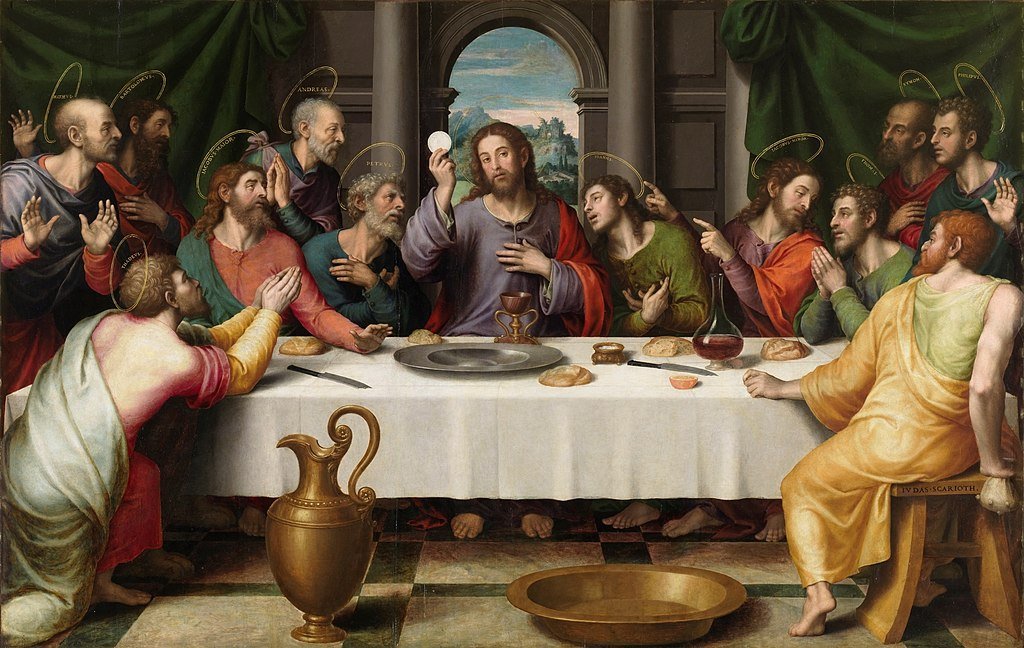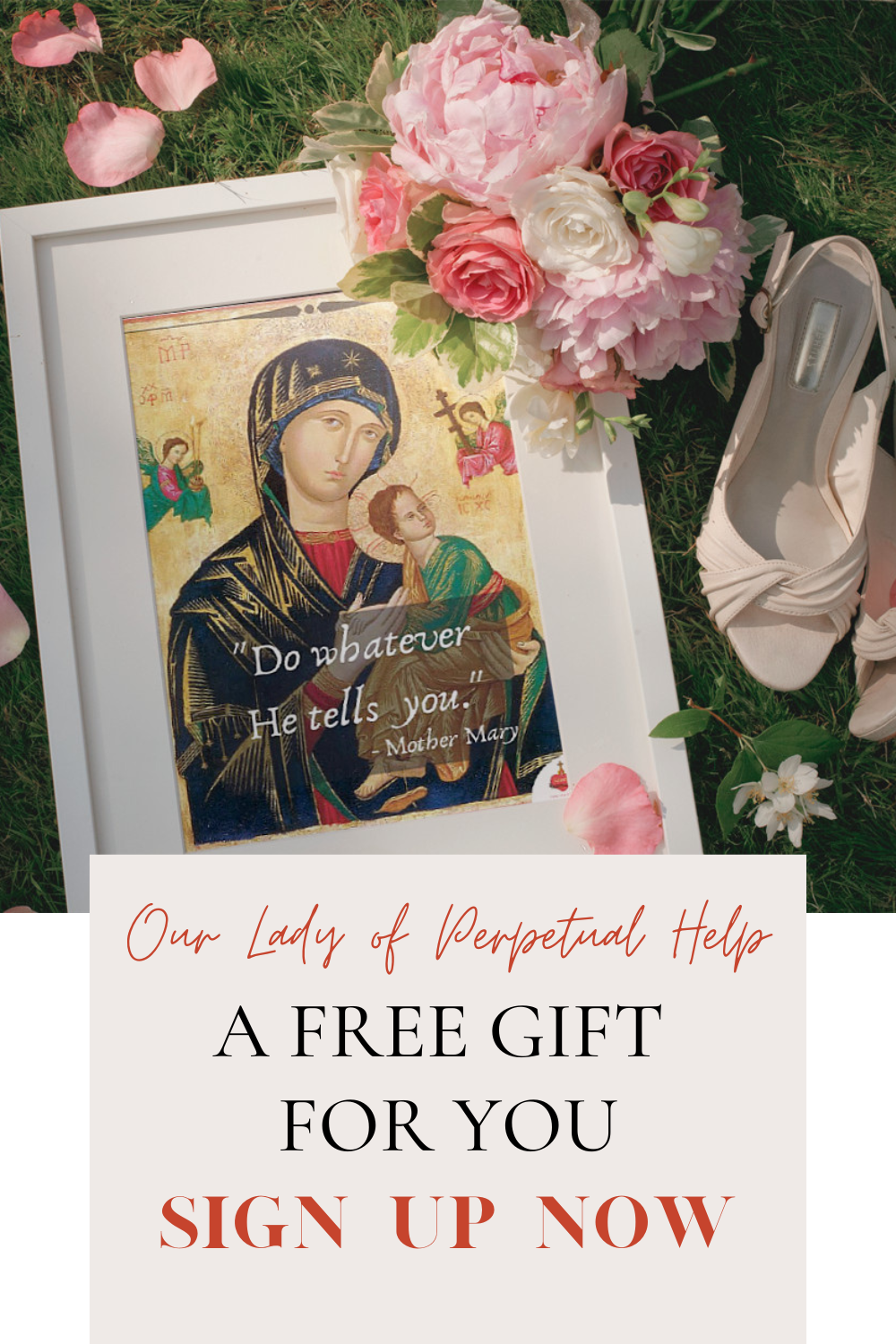Feast Corpus Christi: Experience the Divine -14 Facts on this Most Holy Celebration
Feast Corpus Chisti is a tremendous veneration and devotion. Feast Corpus Christi is at the heart of the Catholic faith and should be shouted from the rooftops for all to hear and understand.
As we examine the history, traditions, and spiritual significance of the Feast Corpus Christi, we will learn the Eucharist’s significance, the Catholic prayer for Corpus Christi, and the various ways we might commemorate and celebrate Feast Corpus Christi.
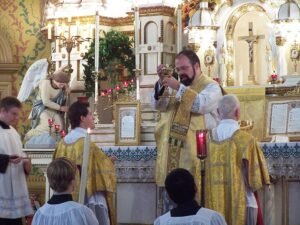
What Does Corpus Christi Symbolize?
The Most Holy Eucharist is a sacrament of the Catholic faith when the priest asks God to change the bread and wine into the true body of Jesus. This is known by the Latin title Corpus Christi, which refers to Jesus Christ’s physical presence there. We believe that during the Mass when the priest does this and after all of the congregation which the Bible refers to as a Royal Priesthood (1 Peter 2:9) that Christ becomes truly present in the bread and wine and that the bread and wine encompass His full body, blood, soul and divinity of our Lord Jesus Christ.
We are following what Jesus taught us to do in the Last Supper. After sharing bread and wine with his followers at the Last Supper, Jesus commanded them to “do this in remembrance of me.” This instruction is the source of this belief.
According to Catholics, partaking in the Eucharist is a way to receive Christ’s grace and develop a connection with him. As they consume his body and blood, it serves as a powerful symbol of the unity between Christ and his disciples. This oneness and the power of the Eucharist to draw people to Christ are both celebrated on Corpus Christi.
Why Do We Celebrate the Feast of Corpus Christi?
Feast Corpus Christi is celebrated on the Thursday that follows Trinity Sunday, the first Sunday after Pentecost. In the 13th century, the first Feast Corpus Christi celebration took place in Liege, Belgium, when a nun named Juliana of Liège had a vision of Christ showing her a moon with a dark spot, which represented the absence of a Eucharist-celebrating Feast Corpus Christi in the liturgical calendar. She reported this vision to the bishop of Liege, who in 1264 established Corpus Christi as a holiday.
Catholics recognize the Eucharist and Christ’s presence in their lives on Corpus Christi. We use this occasion to ponder the Eucharist’s importance to our religion and to show our appreciation for the gift of Christ’s body and blood.
We commemorate Corpus Christi with processions, music, and food to emphasize the joy and togetherness brought about by Eucharistic communion.
A significant holiday for Catholics worldwide is Corpus Christi. It represents both the communion between Christ and his disciples and the presence of Christ in the Eucharist. Catholics commemorate this day to show their thanks for Christ’s body and blood and to appreciate the Eucharist. As we celebrate Corpus Christi, ponder how the Eucharist draws us nearer to Christ and one another.
Why Is Corpus Christi Always on a Thursday?
Corpus Christi is always celebrated on a Thursday, as it is traditionally held the Thursday after Trinity Sunday. Trinity Sunday is the first Sunday after Pentecost, which celebrates the descent of the Holy Spirit upon the apostles. On the Thursday following Trinity Sunday, the Eucharist, the sacrament that symbolizes Christ’s presence through bread and wine, is celebrated.
In the Middle Ages, Pope Urban IV established the tradition of celebrating Corpus Christi on Thursday. Since then, it has been celebrated on the Thursday following Trinity Sunday, with regional variations based on local customs.
Is Corpus Christi a Holy Day of Obligation in the US?
Corpus Christi is not an obligatory religious holiday in the United States. This indicates that Catholics are not required to attend Mass on this day, although it is strongly recommended. Feast Corpus Christi is considered a solemnity by the Catholic Church, which is a celebration of great significance.
Catholics are obligated to attend Mass on Corpus Christi Day in nations like Italy and Spain. In the US, there is no Corpus Christi Mass obligation for individual Catholics. Even so, numerous parishes commemorate the occasion with unique Masses and processions, and it continues to be a significant day on the Church’s calendar.
Feast Corpus Christi is always celebrated on a Thursday, as Trinity Sunday, the first Sunday following Pentecost, immediately precedes it. In the United States, it is not a holy day of obligation, but it remains a significant Catholic celebration.
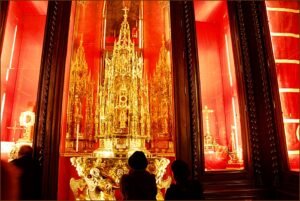
What Do You Do on Feast of Corpus Christi?
During these Masses and processions, the Eucharist is carried through the streets and exhibited. Numerous parishes adorn their altars and churches with flowers and other decorations to commemorate the occasion.
In addition to attending Mass and participating in processions, Catholics can observe Feast Corpus Christi by devoting time to prayer and reflection. You can do this by yourself or with your family as a way to express your thanks for receiving Christ’s body and blood as a gift.
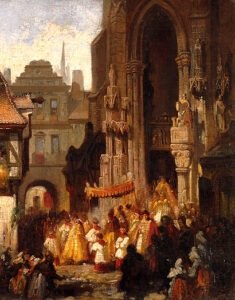
What Are the Colors for Corpus Christi?
The colors associated with the Feast Corpus Christi are white and gold. White represents Christ’s presence at the Eucharist because it is traditionally associated with holiness and purity. Gold, on the other hand, represents God’s glory and majesty and is used to emphasize the festivity’s significance and significance.
In addition to white and gold, many parishes may also use other colors to decorate their churches and altars. Red may represent the blood of Christ, while green may represent the fresh life and growth that come from partaking of the Eucharist.
The Catholic Church observes Feast Corpus Christi with special Masses, processions, and decorations. Attending Mass, spending time in prayer and thought, and expressing thanks for Christ’s presence in their life are all appropriate ways for Catholics to mark this festival. The purity, holiness, and glory of the Eucharist are represented by the colors white and gold, which are connected to Feast Corpus Christi.
What Do You Call the Cross with the Corpus Christi on It?
The cross that contains Corpus Christi is called a monstrance. This is the vessel used to display the consecrated host, which is the bread transformed into the body of Christ during the Eucharist. The monstrance is typically made of gold or silver and is designed to be ornate and beautiful to represent the significance and value of the Eucharist.
The monstrance is displayed and paraded through the streets during the Feast Corpus Christi so that the faithful may see and revere the Eucharist. This procession powerfully conveys Christ’s presence in the world and the importance of the Eucharist in church life.
What Are the Teachings on Corpus Christi?
The Eucharist is the body and blood of Christ and a gift from God that bestows grace and salvation onto the faithful. This concept is based on Jesus’ last supper remarks, “This is my body, given for you” (Luke 22:19).
Jesus also states in John 5:63…
“Truly, truly, I say to you, unless you eat the flesh of the Son of Man and drink his blood, you have no life in you.
According to Catholic doctrine, the Eucharist is a sacrament, or a physical manifestation of an immaterial reality. Catholics hold that the Eucharist strengthens and nourishes them for the journey of life as well as draws them closer to Christ and one another.
The Feast Corpus Christi has substantial social and cultural components in addition to its spiritual significance.
The Church should use this opportunity to spread its message of love and hope to as many people as we possibly can.
A monstrance is the cross upon which the Corpus Christi is displayed and venerated during the Feast Corpus Christi.
This core belief of Catholicism is honored particularly during the Feast Corpus Christi.
The Catholic Church assembles to celebrate the Eucharist and consider its spiritual importance during the Feast Corpus Christi. The Church also uses this occasion to spread its message of love and hope to the wider community. The Corpus Christi lessons serve as a reminder of the Eucharist’s importance in our lives as well as its divine gift.
The Catholic Church celebrates Corpus Christi with great jubilation and festivity. It is an occasion for community gathering and contemplation of the Eucharist’s spiritual significance. The cross bearing the Corpus Christi is called a monstrance, and it is used to display and venerate the Eucharist during the feast. The Corpus Christi teachings remind us of the significance of the Eucharist and the salvation and grace it brings to our lives.

How Can I Make a Pilgrimage to See Where Corpus Christi All Began?
The beauty of Feast Corpus Christi and what Christ gave us through the institution of the Most Holy Eucharist is that he proclaims…
Jesus meant that He is physically present in every Catholic church on earth when He said in Matthew 28:20, “Look, I am with you until the end of the age.”
The Holy Eucharist and His holy Church will continue to be with us as long as God sustains the planet, as He also vowed that the gates of hell would not prevail against the Church.
On Feast Corpus Christi, you can be physically present with Christ by attending daily Mass at your local church parish. Hallelujah! What an incredibly unique gift Jesus has bestowed upon us!
You can also deepen your Catholic faith by making a pilgrimage to the very first location where Christ instituted the Most Holy Eucharist, the Last Supper room in Israel.
Many devoted Catholics from all over the world yearn to travel to the ancient Feast Corpus Christi celebration places on pilgrimage. One of these places where the Catholic faith has deep roots is Israel. We will go over how to visit the places where Feast Corpus Christi and other Catholic holidays originated in Israel in this article.
The Last Supper Room is a must-see for Catholics on a journey to Israel’s holy sites. Many Catholics around the world have special feelings for this place since it is thought that Jesus ate his last meal here with his apostles before being crucified.
To make a pilgrimage to the Last Supper Room in Israel, a number of considerations must be made.
You must make travel plans before visiting Israel, which entails reserving housing and airfare.
You must travel to Jerusalem’s Old City to find the Last Supper Room once you’ve arrived in Israel. On the second floor of the King David’s Tomb complex, next to the Zion Gate, is where this ancient site is situated. You can get there by walking or by taxi.
Upon arrival, the beauty and significance of the Room of the Last Supper will astound you.
The walls of this room, which has been conserved for generations, are decorated with paintings and symbols that explain the significance and background of this sacred area.
You might experience a sense of reverence and serenity when standing in the Room of the Last Supper. Many Catholics place great spiritual importance on this location because it was where Jesus and his apostles met for a supper and to hear his teachings. While you reflect and pray, think about lighting a candle or leaving a modest gift as a token of your commitment.
An effective method to strengthen your faith and connect with the lengthy history of the Catholic Church is to make a pilgrimage to the Room of the Last Supper in Israel. If you approach this sacred place with care and awe, you will be able to recognize its beauty and significance.
What Other Catholic Things Are There to Do and See in Israel?
Israel is a diverse and rich destination for Catholic pilgrims due to its abundance of holy sites and landmarks. Some of the most popular Catholic sites in Israel are listed below:
The Church of the Holy Sepulchre in Jerusalem is my absolute favorite site. It was here that our Lord was Crucified, buried, and rose again! No journey to the Holy Land is complete without going here.
The Mount of Beatitudes is a popular destination for pilgrims interested in Jesus’ teachings.
Mary was visited by the angel Gabriel in the Church of the Annunciation in Nazareth and told she would become the mother of Jesus. Her house here is only a replica since the original was moved to preserve it during the Ottoman Empire’s reign when they tried to destroy everything that was Christian.
But, the location is accurate regarding where the original house was and the spot where:
“The Word Became Flesh” John 1:4
Jesus is supposed to have worked many miracles near the Sea of Galilee, including walking on water and calming a storm.
Catholics frequently travel to the Wailing Wall in Jerusalem, one of Judaism’s holiest sites, to worship and reflect on their religious beliefs.
Other Catholic activities and attractions in Israel include museums, monasteries, and pilgrimage routes. Regardless of their interests, Israel offers numerous opportunities for Catholic pilgrims to deepen their faith and connect with the roots of their religion.
An effective method to bolster your faith and establish a connection with the Catholic Church’s history is to make a trip to the Feast Corpus Christi origins. Because of the famous Eucharistic miracle that is supposed to have happened there in the 13th century, Bolsena, Italy, is a popular destination for pilgrims.
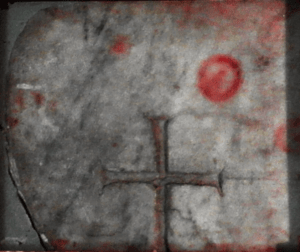
Israel is a diverse and rich destination for Catholic pilgrims due to its abundance of holy sites and landmarks. Israel provides many possibilities to strengthen your faith and get in touch with your religion’s roots, regardless of your interest in Church history or the teachings of Jesus.
Making Travel Arrangements to Visit Israel:
Catholics who wish to deepen their faith and connect with the origins of their religion may find planning a trip to Israel to be an exciting and spiritual endeavor.
Israel is where Jesus was crucified, died, and was buried. It’s also where he rose from the dead! This makes Israel the most holy place in the world.
You must plan ahead and make the required travel arrangements if you want to make the most of your time in Israel. Here are some factors to consider:
- Visa and Entry Requirements: Prior to booking your trip, confirm Israel’s visa and entry requirements. Check to see if you need a visa. You’ll definitely need your passport.
- Flights and Lodging: To receive the best rates and to ensure availability, book your flights and lodging in advance. Consider hiring a local tour guide to help you explore the area as you look for hotels near the attractions you wish to see.
- A sufficient amount of travel insurance should be purchased to cover unforeseen circumstances like trip cancellation and medical problems.
- Consider the places and activities you want to visit and attend while making your itinerary in advance. Give yourself enough time to rest and think.
Traveling has helped me to grow in my faith, and I believe it may do the same for you.
Strolling through the Vatican, exploring the Holy Land, and following in the last footsteps of the Korean saints before they were killed for their religion. Those are the times in life when the purpose of our being and what God intends for us to do with our lives becomes clear.
I’ve traveled extensively. Among the countries I’ve visited are America, Scotland, Korea, Hong Kong, Macau, The Vatican, Switzerland, France, Milan, and all of Israel. I’ll soon be in Turkey, too.
I am familiar with all of the travel essentials. Because of this, I’ve created a list of quick links to help you get ready for your trip.
Click on the following links to prepare for your spiritual journey, and remember to bookmark this page so you may easily return to it later:
- Find cheap flights for your journey HERE
- A Car Rental
- Taxi Drivers
- Bus or Train Tickets
- Choose the Perfect Hotel for Your Trip HERE
- Fun Events for Your Journey
- Travel Insurance
- Phone for Traveling
Time to pack your bags! 🙂
What is the Spiritual Message of the Feast of Corpus Christi?
The celebration acknowledges both the community of Christians who partake in this sacrament and the actual presence of Christ in the Eucharist. It also sends out a spiritual message of peace and love.
We get a chance to ponder the Eucharistic mystery and broaden our awareness of its spiritual meaning during the Feast Corpus Christi. We connect to Him and to one another through the Eucharist, creating a spiritual community that is defying time and geography.
As we express thanks for the gift of the Eucharist and the sacrifice of Christ that it symbolizes, the spiritual message of Feast Corpus Christi is one of respect and thankfulness. By reaffirming our dedication to Christ and to one another as Christians, we can deepen our faith and become nearer to God.
Finally, organizing a trip to Israel to observe Feast Corpus Christi holiday can be a significant and life-changing event for any Catholic. We can enhance our awareness of the Eucharist and fortify our ties to Christ and one another by planning our journey appropriately and pondering on the spiritual message of the feast.
What are the 3 purposes of Feast Corpus Christi including to honor our Lord truly present in the Eucharist?
One of the most important occasions on the Catholic calendar is the Feast Corpus Christi. As a celebration of the actual presence of Jesus Christ in the Eucharist, it supports Christians’ faith and spiritual ardor. Each of the feast’s three main objectives will be covered in more depth below.
To Praise the True Presence of Our Christ in the Eucharist
Honoring our Jesus who is genuinely present in the Eucharist is the primary goal of Feast Corpus Christi. It is held to be the actual body and blood of Christ, making this sacrament the most revered and important component of Catholic liturgy. The Eucharist is placed in a monstrance and carried during the feast as a representation of Christ’s presence in the world.
To Show Appreciation for the Eucharistic Gift
Gratitude for the Eucharist’s gift is the second reason for celebrating Corpus Christi. Catholics hold that they can partake in Christ’s divine life and gain spiritual nourishment through this sacrament. We have the opportunity to express our thankfulness for this gift during Feast Corpus Christi, as well as to recommit to living a life of devotion and faith.
To foster cooperation and neighborhood among believers
Promoting fellowship and togetherness among Christians is the third goal of Feast Corpus Christi.
The Eucharist symbolizes the communal element of Catholic liturgy, and Feast Corpus Christi aims to unite people in a celebration of their shared faith. The Eucharistic procession through the streets serves as a potent reminder of the unity and closeness of the Catholic community as well as the value of encouraging one another on our spiritual journeys.
What is the Catholic Prayer for Corpus Christi?
The “Sequence” is the name of the Corpus Christi prayer in the Catholic tradition. It is a song that is sung or read aloud during the celebration of Feast Corpus Christi in order to convey the Eucharist’s profound spiritual importance. The Sequence is a lovely prayer that emphasizes the sanctity of the Communion and serves as a potent reminder of its significance in Catholic devotion.
The words “Lauda Sion,” which translate to “Praise, O Zion,” are the first in the Sequence. The miraculous aspect of the Communion is further described, highlighting the notion that Christ is actually present in the sacrament. The prayer also considers Christ’s atonement and the spiritual refueling we experience through the Eucharist.
Feast Corpus Christi promotes community among believers, expresses thankfulness for this gift, and recognizes the genuine presence of Christ in the Eucharist. The Sequence, a traditional Catholic prayer for Feast Corpus Christi, is a lovely representation of the feast’s spiritual significance and a potent reminder of the centrality of the Eucharist in Catholic devotion.
Are You Inspired?
Did today’s lessons provide you with any inspiration? I enjoy reading about and discussing the lives of the saints. It has the potential to yield a lot of spiritual fruit in our lives.
Would you prefer a short topic of conversation?
If you’re wearing the stunning shirt I made just for you, you won’t have any trouble telling the Feast Corpus Christi story.
Wearing these t-shirts makes it exciting to discuss saints with close friends, family, and complete strangers. You may now share the remarkable story of Feast Corpus Christi when someone asks what your shirt says.
They might even decide to accompany you to church. Better yet, you can preach the Gospel to them, which will aid in the salvation of their souls. They need a Savior because, according to Romans 3:23, “all have sinned and fall short of the glory of God.” You can explain this to them.
And that in order to redeem those who were under the law so that we could become His children, God sent His one and only son to live under the law. (4:15–16 in Galatians)
Jesus had to come to earth, suffer, and die for us in order to atone for our sins. According to the Bible,
“Indeed, under the law almost everything is purified with blood, and without the shedding of blood there is no forgiveness of sins.”
– Hebrews 9:22
Send your loved ones or new friends an invitation to RCIA (the Ritual of Christian Initiation for Adults) at their local church. Students can learn everything they need to know about our magnificent Christian religion and our Compassionate Jesus by enrolling in the RCIA classes that their church offers.
Simply click the image to view the shirt design or go HERE. To be taken to the checkout page, choose your favorite size and color, then click the BUY NOW button.

For more great saints, visit our blog HERE.
Have a few more minutes to dive into another saint?
Why not learn about:
- St. Joan of Arc – Unleash Your Inner Warrior: 21 Inspiring Facts of the Story of Her Life
- The Incredibly Inspiring Journey of St. Rita of Cascia: 13 Facts on Her Testament to Perseverance
- 13 Facts and Tips: The Ultimate Guide to Praying St Ritas Novena and Invoking Divine Intervention
- Unlocking 14 Secrets of St. James the Less: The Saint Who Defied All Odds
Have you considered coming here every day to learn more about the Saint of the Day? Please take a moment to sign up if you would want to receive my daily saint emails in your inbox. I’ll keep it short since I know you have a lot on your plate, but I’ll say more because I want you to learn from my experience and grow every day with saints like me.
Together with the gift, I’ll provide a complimentary phone screensaver. I’ll email you a link to download the screensaver as soon as you submit the form. Enjoy!
Well, that’s all for today.
I’ll see you back tomorrow with another Saint of the Day to inspire you!
God bless you,
-Priscilla

